Galapagos Islands Names: Guide to All 33 Islands, Islets (Map)
Galapagos Islands’ names can be confusing. Almost every one of the Islands has at least two names: Spanish and English. Most of the names aren’t translations, but totally different names. Because the Islands belong to Ecuador, a Spanish country, we will refer to them by their Spanish names.
Many islands in the Galapagos Islands have 2 (or more) names. Most are Spanish and some names are English. The Galapagos archipelago itself has been known by many different names over the years. There are 18 named Galapagos Islands that are larger than 1 square kilometer (0.39 square miles).
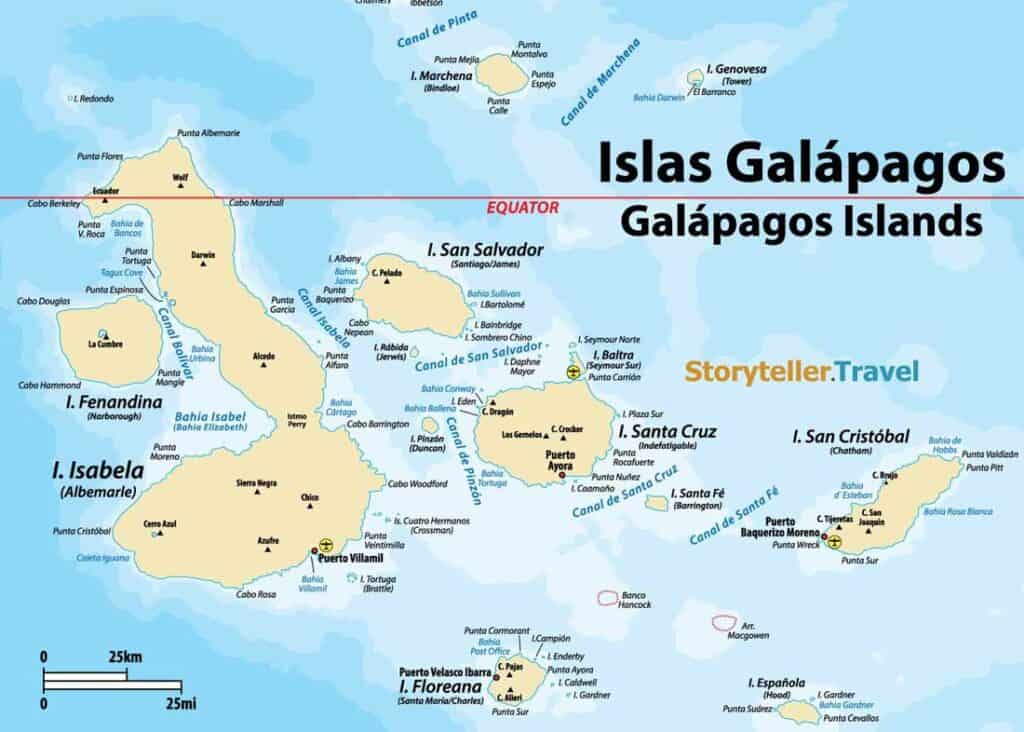
Understanding the duel names of many Galapagos Islands is important as you plan your trip. Some guidebooks and websites still predominately use English names.
Guide to Galapagos Islands Names
Each island is named, many with more than one. And the archipelago itself also has had numerous names over the years.
7 Names of the Galapagos Archipelago
Here are some of the names and expressions used to describe the Galapagos Islands over the years.
- The Enchanted Isles (Encantadas in Spanish). From a novella by Herman Melville, American author.
- Insulae de los Galopegos (Islands of the Tortoises). This name was used in Abraham Ortelius’s 1570 atlas. The word insula is Latin for “island” (plural insulae).
- The Galapagos (its common name today). In Spanish, they are known as Islas Galápagos.
- Archipiélago de Colón (its official name). The Ecuadorian government gave the Galapagos its officical name in 1892, 400 years after Columbus famous voyage.
Along with the surrounding waters, the Galapagos Islands also form:
- Galapagos Province. This is one of 24 Ecuador provinces.
- Galapagos National Park. This is one of 11 national parks in Ecuador.
- Galápagos Marine Reserve
18 Main Galapagos Islands
These are the names of the largest islands in the Galapagos. They all have a surface area of at least 0.39 square miles (1 square kilometer).
The first name is the common name, predominantly Spanish. The second name is less commonly used, and they are mostly in English. The name in brackets is their less common Spanish name.
- Baltra, South Seymour
- Bartolomé, Bartholomew
- Darwin, Culpepper
- Española, Hood
- Fernandina, Narborough
- Floreana, (Santa Maria), Charles
- Genovesa, Tower
- Isabela, Albemarle
- Marchena, Bindloe
- North Seymour Island, Seymour
- Pinta, Abingdon
- Pinzón, Duncan
- Rábida, Jervis
- San Cristobal, Chatham
- Santa Cruz, Indefatigable
- Santa Fe, Barrington
- Santiago, (San Salvador), James
- Wolf, Wenman
Generally speaking, you’ll find the Spanish names used while visiting the Galapagos Islands.
15 Smaller Galapagos Islands & Islets
Here are the four small (minor) islands from the Galapagos.
- Daphne Major
- Plaza Sur, South Plaza Island
- Roca Redonda, Rock Redondo
- Sin Nombre, Nameless Island
Here are 11 small islands and islets.
- Caldwell
- Champion
- Cowley
- Crossman
- Eden
- Enderby
- Gardner
- Isla Guy Fawkes
- Onslow
- Tortuga, Brattle
- Watson
Map of Galapagos Islands Names
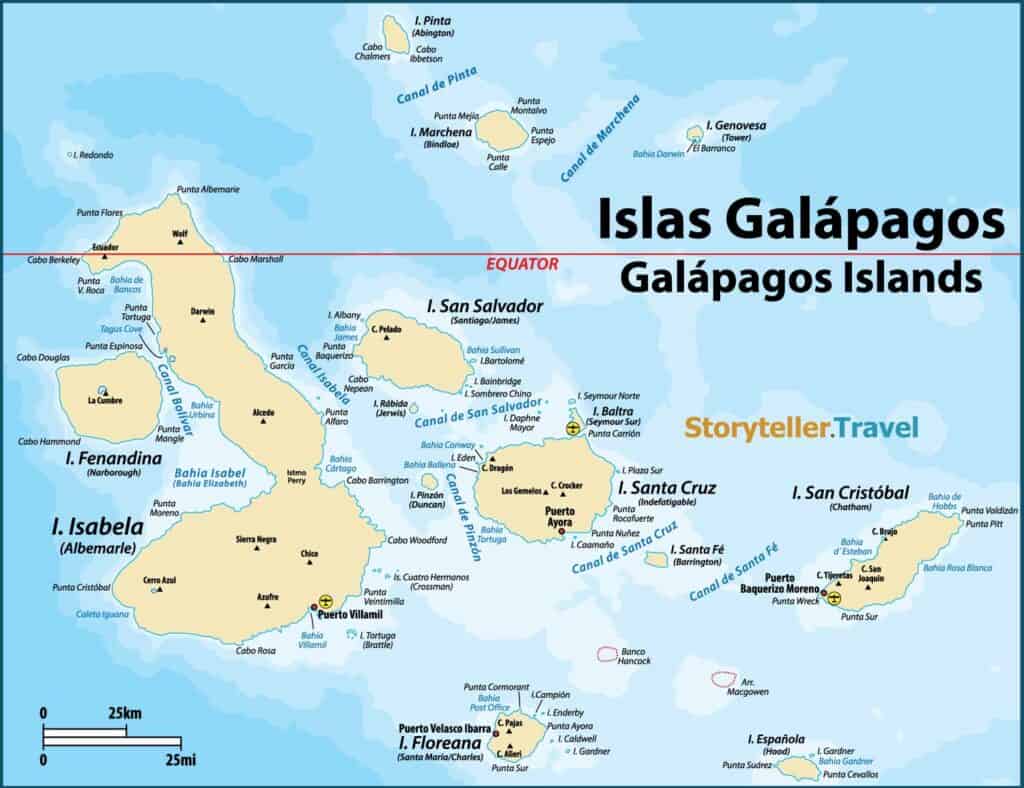
Missing from the map above are Wolf and Darwin Islands. You can find them in the map at the end of the post. To enlarge the map, just open the image in a new tab.
Guide to the 18 Main Galapagos Islands
Here are the 18 main islands of the Galapagos (based on size, all are larger than one square kilometer):
1. Baltra Island
- English Name: South Seymour
- Located north of Santa Cruz Island and was created by geological uplift.
- Interesting fact: Home to Baltra Airport, one of the two primary airports in the Galapagos. Baltra Island was home to a US military base until the end of World War 2.
Learn more in our Baltra Island Visitor Guide.
2. Bartolomé Island
- English Name: Bartholomew Island
- Interesting fact: This Island is named after Sir Bartholomew James Sulivan, who was a Lieutenant on HMS Beagle and a good friend of Charles Darwin.
3. Darwin Island
- English Name: Culpepper Island
- Size: 1.1 square kilometers (0.4 sq mi) and a maximum elevation of 168 meters (551 ft)
- Interesting fact: This island is named after Charles Darwin.
4. Española Island
- English Name: Hood Island
- Size: 60 square kilometers (23 sq mi) and a maximum elevation of 206 meters (676 ft)
5. Fernandina Island
- English Name: Narborough Island
- Size: 642 square kilometers (248 sq mi) and a maximum elevation of 1,494 meters (4,902 ft)
- Interesting Fact: One of just two islands with volcanic activity, Fernandina last erupted in April 2009.
6. Floreana Island
- English Name: Charles Island
- Secondary Name: Santa María Island
- Size: 173 square kilometers (67 sq mi) and a maximum elevation of 640 meters (2,100 ft)
- Interesting Fact: Home to Post Office Bay – where whalers and travelers kept a barrel (aka: Post Office) where mail was dropped off, then picked up by another traveler heading in that direction.
We had the most exceptional sea lion experience on Floreana.
7. Genovesa Island
- English Name: Tower Island
- Size: 14 square kilometers (5.4 sq mi) and a maximum elevation of 76 meters (249 ft)
- Interesting fact: Nicknamed “the bird island”, Genovesa Island is literally filled with birds. Expect to see: frigate birds, red-footed boobies, noddy terns and swallow-tailed gulls, among many others.
8. Isabela Island
- English Name: Albemarle Island
- Size: 4,640 square kilometers (1,792 sq mi) and a maximum elevation of 1,707 meters (5,600 ft)
- Interesting fact: This is the largest of all the islands and was formed when six volcanoes merged into one land mass. The equator runs across the northern section of this island, making it the only place in the world where penguins live naturally in the Northern Hemisphere. The third-largest town in the Galapagos, Puerto Villamil, is located on the southern coast.
Did you know? Galapagos has 21 volcanoes. Learn all about Galapagos volcanoes.
9. Marchena Island
- English Name: Bindloe Island
- Size: 130 square kilometers (50 sq mi) and a maximum elevation of 343 meters (1,125 ft)
10. North Seymour Island
- Alternative Name: Seymour Island
- Size: 1.9 square kilometers (0.7 sq mi) and a maximum elevation of 28 meters (92 ft)
- Interesting fact: Created by a geological uplift like its sister island of Baltra (South Seymour) and is home to one of the largest populations of frigate birds.
11. Pinta Island
- English Name: Abingdon Island
- Size: 60 km2 (23 sq mi) and a maximum elevation of 777 meters (2,549 ft)
- Interesting fact: Lonesome George, a Pinta tortoise and the last of his species is originally from this island, but is now kept on Santa Cruz Island at the Charles Darwin Research Station.
12. Pinzón Island
- English Name: Duncan Island
- Size: 18 square kilometers (7 sq mi) and a maximum elevation of 458 meters (1,503 ft).
13. Rábida Island
- English Name: Jervis Island
- Size: 4.9 square kilometers (1.9 sq mi) and a maximum elevation of 367 meters (1,204 ft)
- Interesting fact: Rábida gets its unique redish color from the high levels of iron in the lava.
14. San Cristóbal Island
- English Name: Chatham Island
- Size: 558 square kilometers (215 sq mi) and its highest point rises to 730 meters (2395 ft)
- Interesting fact: Home to the provincial capital: Puerto Baquerizo Moreno and Laguna El Junco, the largest freshwater lake in the Galapagos.
15. Santa Cruz Island
- English Name: Indefatigable Island
- Size: 986 square kilometers (381 sq mi) and a maximum elevation of 864 meters (2834 ft)
- Interesting fact: Home to Puerto Ayora (the largest town in the Islands), the Charles Darwin Research Station, and Tortuga Bay.
You can find Las Grietas in Santa Cruz Island. You might even see Darwin’s cotton on the walk there.
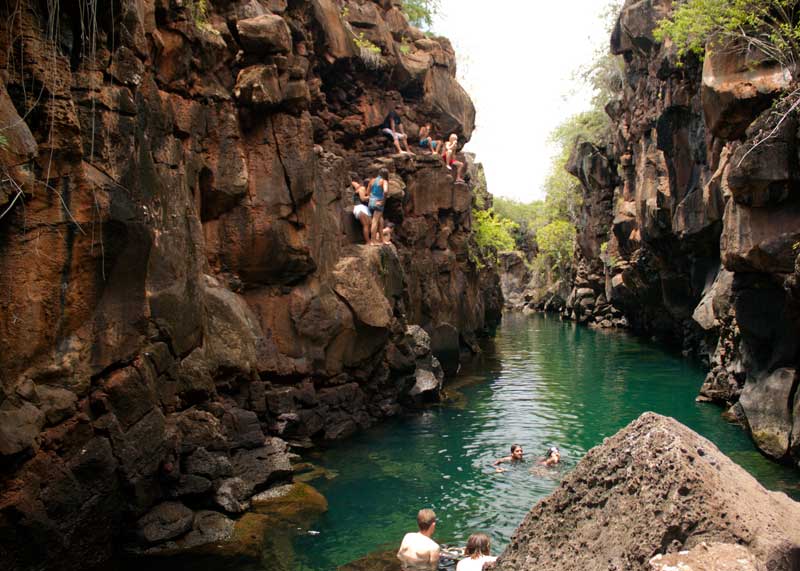
16. Santa Fé Island
- English Name: Barrington Island
- Size: 24 square kilometers (9 sq mi) and a maximum elevation of 259 meters (850 ft)
- Interesting fact: Swallow-tailed gulls, shear-waters petrels and red-billed tropic birds nest in the coastal cliffs of Santa Fe Island.
Learn more about the wildlife in our Travelers Guide to Galapagos Animals.
17. Santiago Island
- English Name: James Island
- Secondary Name: San Salvador Island
- Size: 585 square kilometers (226 sq mi) and a maximum elevation of 907 meters (2976 ft)
- Interesting fact: The human introduced pigs and goats have been completely eradicated (pigs in 2002, goats by 2006).
18. Wolf Island
- English Name: Wenman Island
- Size: 1.3 square kilometers (0.5 sq mi) and a maximum elevation of 253 meters (830 ft)
- Interesting fact: The Vampire Finch, which feeds partly on blood from other birds, is only found on this Island
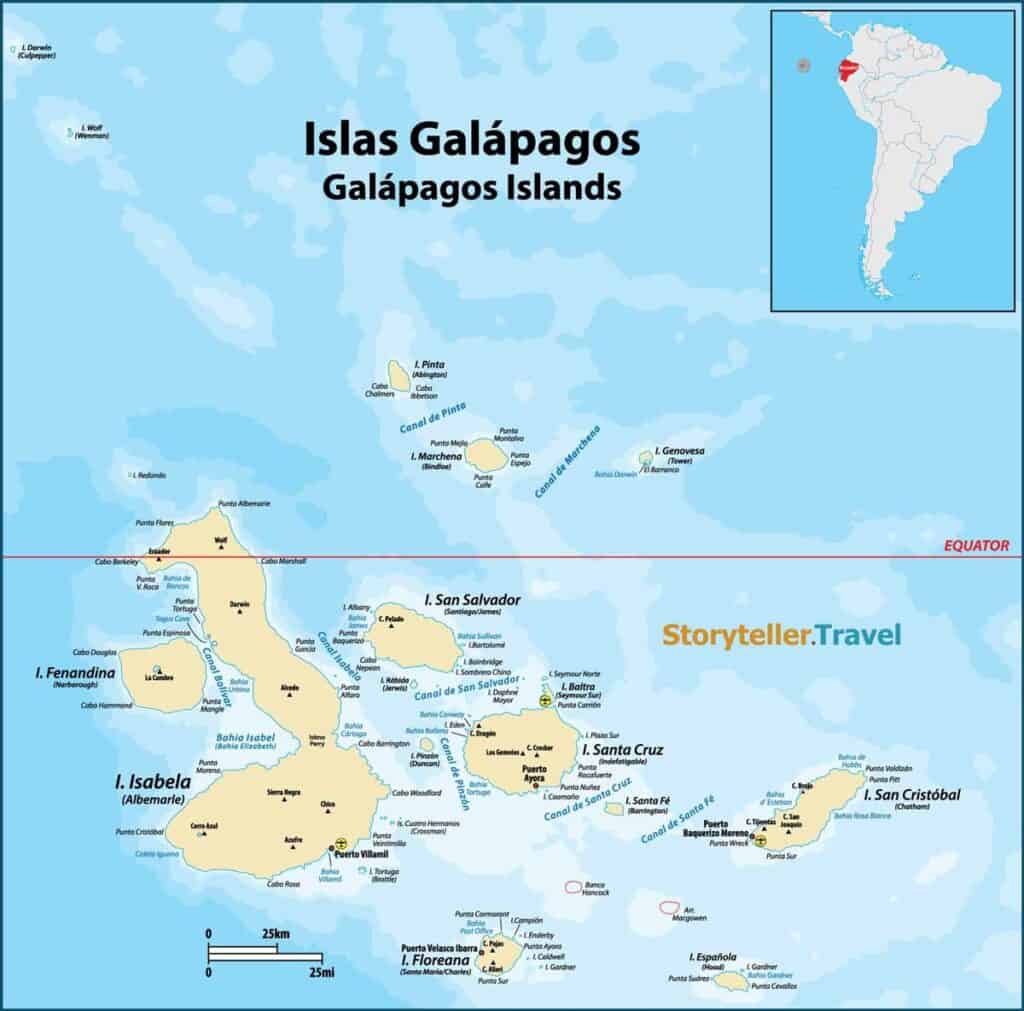
Learn more with these 25 Galapagos Islands Facts for Travelers
More About Galapagos Islands Names
How Many Islands are in the Galapagos?
There are 18 primary islands in the Galapagos. Plus three smaller islands, and 107 rocks and islets. This makes a total of 128 islands, islets, and rocks in the Galapagos Islands.
3 Primary Islands in the Galapagos
While traveling in the Galapagos, you will want to be familiar with 3 main islands: Santa Cruz, Isabela, and San Cristóbal Islands.
And while you’ll land at Baltra Airport (on Baltra Island) there isn’t much to see there.
And while you can visit Floreana Island, it isn’t a top destination.
10 Most Popular Galapagos Islands
Aside from the populated islands, with all the hotels, here are the Galapagos Islands that tourists love.
- Bartolome Island
- Española Island
- Fernandina Island
- Genovesa Island
- Isabela Island
- North Seymour Island
- Rábida Island
- Santiago Island
- Santa Fe Island
- South Plaza Island
How Many Galapagos Islands are Populated?
Just four of the 18 Galapagos Islands are inhabited year-round: Santa Cruz, San Cristobal, Isabela, and Floreana Islands.
Learn about all the Galapagos volcanoes.
What Are the Best Galapagos Beaches?
The Galapagos Islands are home to countless beautiful beaches. Some of the most beautiful beaches include Tortuga Bay (Santa Cruz), Gardner Bay (Española Island), and Puerto Villamil Beach (Isabela Island).
See our picks for the best Galapagos beaches across 8 islands.
Why Do Some Galapagos Islands Have English Names?
The English names were assigned by Ambrose Cowley, an English buccaneer from the 17th century. Today, the Islands go by their Spanish names, now that they belong to Ecuador, a Spanish-speaking country.
Keep Reading: Where are the Galapagos Located?
Your Turn
Have a question about Galapagos Island? Have a detail to add? Let me know in the comments!

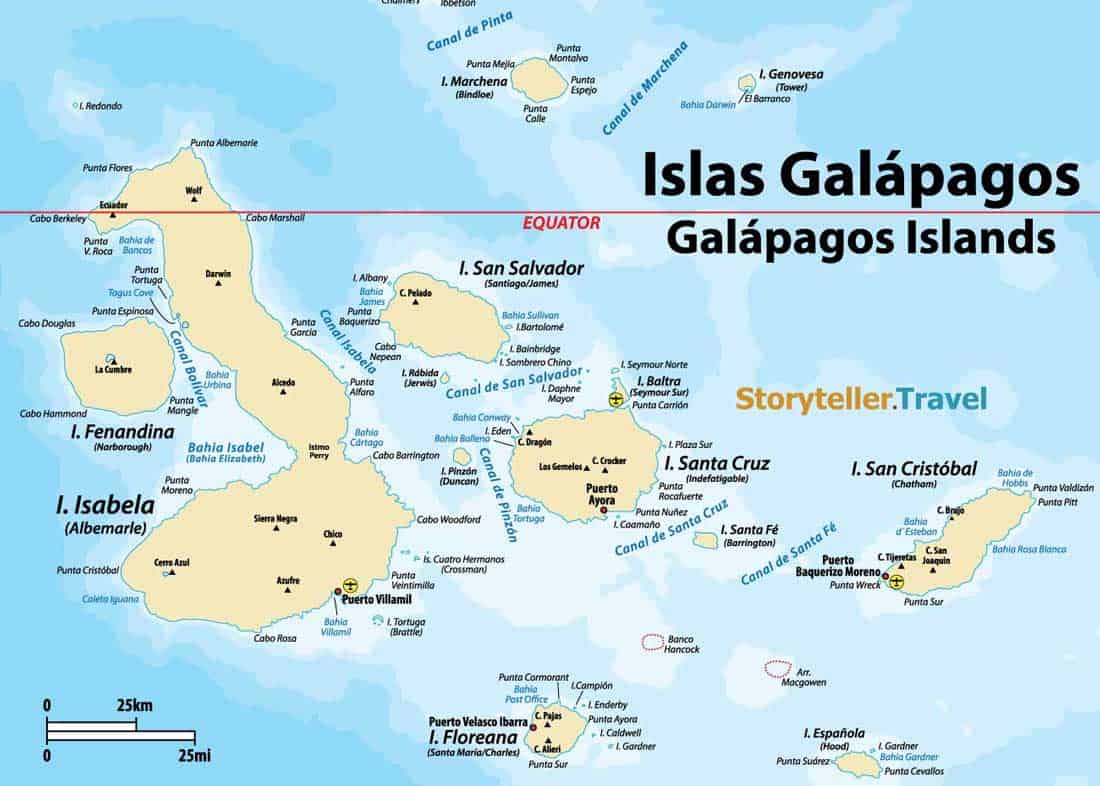


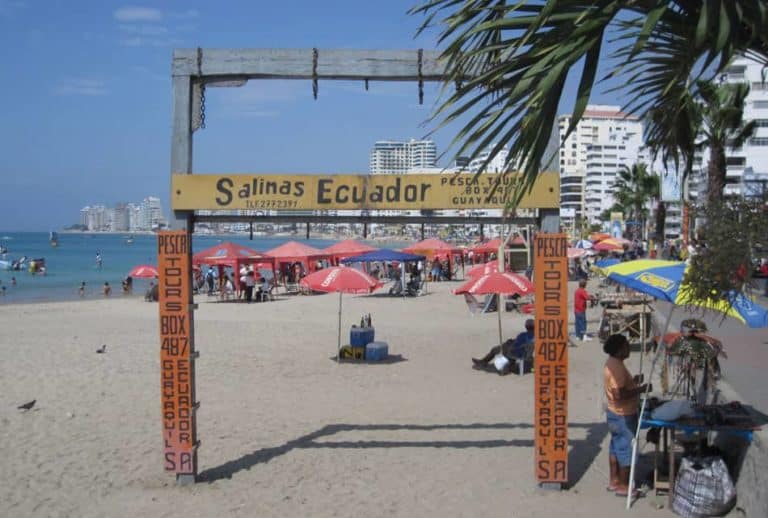
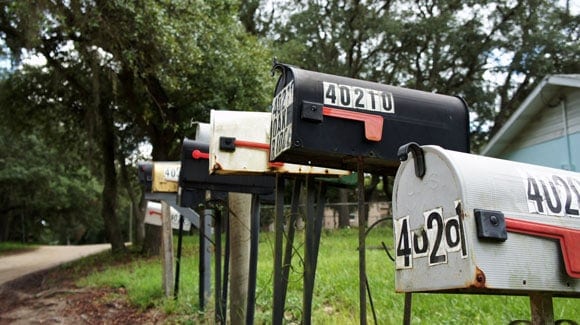


One of the best structured info sites I have seen. We hope to visit mid 2023. 4 senior citizens no diving min snorkelling and are contemplating a land based hopping tour for 5-7 nights. Which would be your top pick islands to ensure that our tour operator covers in our hopping tour and maximize our experience.
Can we use an airport other than Baltra? all operators use Baltra which seems like a waste of a day
You can fly into either Baltra or San Cristobal Island. They are the only airports receiving flights from the mainland.
My favorite islands are Floreana, Isabela, and Santa Cruz – in that order. The are lots of great land-based activities on each of these islands.